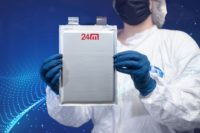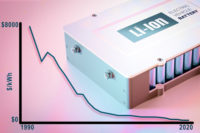TORRANCE, CA—Engineers at the Honda Research Institute here have developed a new type of battery that could replace traditional lithium-ion devices. Fluoride-ion chemistry, developed in collaboration with scientists at the California Institute of Technology and NASA’s Jet Propulsion Laboratory, enables the use of materials with higher energy density and a more favorable environmental footprint than currently available technology.
“Fluoride-ion batteries (FIBs) offer a promising new battery chemistry with up to 10 times more energy density than currently available lithium batteries,” claims Christopher Brooks, Ph.D., chief scientist at the Honda Research Institute. “Unlike lithium-ion batteries, FIBs do not pose a safety risk due to overheating. And, obtaining the source materials for FIBs creates considerably less environmental impact than the extraction process for lithium and cobalt.
“FIBs provide an attractive alternative to other types of potential high-energy battery electrochemistries, such as those based on lithium or metal hydride chemistries, which are generally limited by the inherent properties of their electrodes,” explains Brooks. “Due to the low atomic weight of fluorine, rechargeable batteries based on the element could offer very high energy densities.”
However, while fluoride-ion batteries are considered a strong contender for the next-generation of high-density energy storage devices, they are limited by their required temperature requirements.
“Currently, solid-state fluoride ion-conducting battery iterations need to operate at elevated temperatures above 150 C to make the electrolyte fluoride-conducting,” says Brooks. “These limitations in the electrolyte have presented a significant challenge for achieving low-temperature operating FIBs.”
To address this challenge, Brooks and his colleagues developed a method for creating a fluoride-ion electrochemical cell capable of operating at room temperature
“[This] breakthrough was made possible by a chemically stable liquid fluoride-conducting electrolyte with high ionic conductivity and a wide operating voltage,” notes Brooks. “[We] developed the electrolyte using dry tetraalkylammonium fluoride salts dissolved in an organic, fluorinated ether solvent.”
When paired with a composite cathode featuring a core-shell nanostructure of copper, lanthanum and fluorine, Brooks and his colleagues achieved reversible electrochemical cycling at room temperature.
In the future, fluoride-ion batteries could power electric cars, airplanes and other vehicles. The higher-capacity nature of the battery also makes it a good candidate for cordless power tools and other products.



